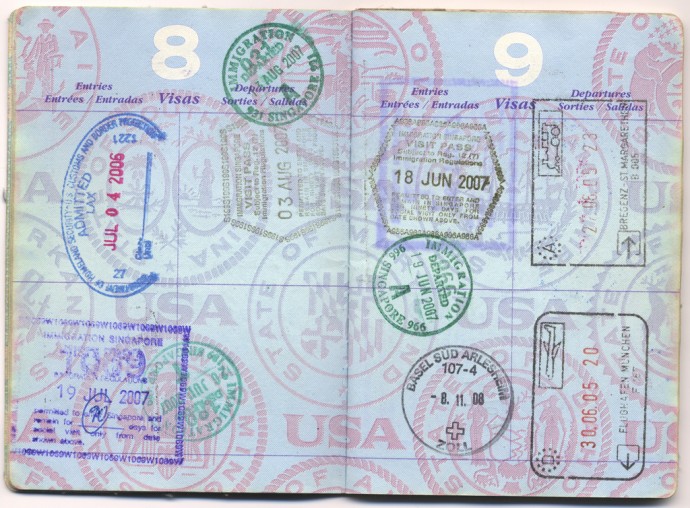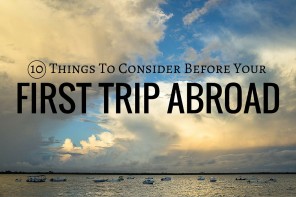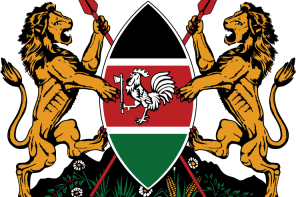One of the first things any traveler should consider when they begin to plan their trip abroad is if they need to obtain a foreign visa in order to travel within their country of interest. This can be a simple process, or a rather complicated one, depending on what countries you want to visit, your length of stay, and other related factors.
In this post, we’ll cover the following topics as they relate to foreign visas:
- Considerations of visas-on-arrival vs. visas-with-prior-arrangements
- Considerations of what type of visa a given traveler needs
- Considerations of visas as they relate to itinerary and method of transit
- Thoughts on visa renewals/extentions
- Notes on Europe and the Schengen Borders Agreement
Let’s begin with the big questions.
CAN I GET A VISA ON ARRIVAL, OR DO I NEED TO APPLY FOR ONE BEFORE I TRAVEL?
Foreign visas are generally issued in one of two ways:
- Visa on Arrival
- Visa with Prior Arrangements
Visas on Arrival are generally easy things. When you arrive in a given country, immigration issues you a visa for a specified amount of time during which you are allowed to be within their borders. You will likely need to fill out a bit of paperwork upon arrival, and possibly provide a passport photo and a bit of other documentation – but for the most part, these procedures are usually quite manageable (though still often annoying and stressful).
Visas with Prior Arrangements are more complex. You may need to fill out forms, pay fees, ship your passport to an embassy, provide proof of travel to the country in question, on and on – each visa for each country can get very specific. Further: you may be required to apply for foreign visas from your home country in some cases – in others, you may be able to apply at foreign embassies/consulates in other foreign countries (for example, I was issued a visa for Myanmar from an embassy visit while I was was in Bangkok, Thailand). The visa-with-prior-arrangement process can be a total breeze, or INCREDIBLY stressful and opaque – it’ll vary by the countries you plan to visit.
The key with either of these is to research whether you need one or the other, MONTHS in advance of your travel. If there’s a 4-week processing time on a given foreign visa, you need to be aware of that and react accordingly.
Note: one cool trick that helps with needs of multiple visas-with-prior-arrangement, or visas needed while traveling, is getting a second U.S. passport (valid for two years).
RELATED POST: How to Get An Indian Visa (as a US Citizen)
CONSIDER WHAT TYPE OF VISA YOU ACTUALLY NEED
Once you’ve figured out if you can get a visa upon arrival, or need to make prior arrangements, consider what TYPE of visa you actually need.
Foreign visas generally fall into a few categories:
- Tourist Visa – for non-business travelers
- Business Visa – for business travelers or potentially those working inside of foreign countries
- Press Visa – visas directly to journalism, filmmaking, news production, etc. Sometimes classified as a business visa instead of as a press visa.
- Transit Visa – for layovers or short windows of travel (required by some countries, others not)
- Student Visa – for students studying in another country
- Diplomatic Visa – for official governmental travel (not my area of expertise)
Some of these visas will allow SINGLE ENTRY to the country (meaning you can only come and go one time), others will allow MULTIPLE ENTRY, meaning you can leave and come back within the period of your visa. Make sure you know which one you need when you apply or arrive – this will likely depend on how your itinerary is planned.
Additionally: what type of visa you may need is not always straightforward – there are a lot of grey areas. My personal thought is that you should keep things as simple for yourself and for customs/immigration officials as you can. No need to ask for undesired attention nor regulation unless absolutely necessary.
A few generalized examples of what visa I think best fits what type of traveler (these are GENERALIZED and do not speak to entry into specific countries, nor to specific socio-political situations in specific countries. Just my general thoughts on how to keep things as simple as possible!):
- If you’re planning on importing / exporting goods or equipment to a country, you will need to follow up on a BUSINESS VISA of some sort. You may also need to discuss import/export lists for all goods/equipment, or an ATA Carnet, if the country in question is a member of the ATA Carnet system.
- If you’re a businessperson making an short, low key, NON-GOVERNMENTAL office visit in a foreign country (or similar), you may be just as well traveling on a TOURIST VISA, especially if the business visa application process is time consuming and/or costly. Lots of people carry laptops and wear suits on planes. No big deal – keep things simple for yourself unless you feel it’d be better to carry a business visa given the nature of your work or the duration of your stay.
- If you’re flying through a restrictive country with a layover, or if you want to leave the airport in a country like China, you may need a TRANSIT VISA, which may or may not require prior arrangements. This will allow you to be in their country for a short period of time without heavier-duty documentation. These can be perfect for short stays – just make sure you understand exactly how many days you’re allowed!
- I can’t exactly speak to government affairs / government travel as it’s not my area of expertise, but I would expect that most any official governmental visit to any country would require some sort of BUSINESS VISA or DIPLOMATIC VISA.
- If you are a professional photographer or videographer traveling with a great deal of recording equipment and/or a crew, you will want to think long and hard about if you want a PRESS VISA or not. This will likely depend on the nature of your project (is it politically motivated, for example?), how restrictive the country you’re traveling to may be about media presence, and how complicated it may be to get press visas. Additionally: consider getting press visas for only PART of your crew, if appropriate (and tourist visas for the rest). Lots of calculated judgment calls here!
- If you are an enthusiast or semi-pro photographer or videographer traveling with consumer level equipment that fits in a backpack or similar low-key cases, shooting for artistic or personal purposes, you will likely want to travel on a TOURIST VISA. Press visas can be difficult and annoying to get, and I don’t recommend messing with them if you don’t have to. Again, judgment call on your part.
- If you are a backpacker working in a hostel or volunteering on an organic farm, you’ll likely want to travel on a TOURIST VISA.
- If you’re studying for a semester in a foreign country, you will likely need some sort of STUDENT VISA. Your academic advisor should be able to help you with this.
- If you are your run of the mill tourist or backpacker traipsing along, just get a TOURIST VISA for the majority of countries you visit. Why are you still reading this section anyway?
CONSIDER THE DURATION OF YOUR TRIP
Planning a 40-day trip in a country that only allows foreigners to stay for 30 days could be a serious contradiction in terms. Make sure you know the maximum number of days on offer by immigration before setting your itinerary in stone.
It’s also worth noting that some countries offer visas of differing duration for those that obtain visas-on-arrival vs. visas-with-prior-arrangements. Make sure you know the difference – this could save you from having to attempt to renew your visa later.
CONSIDER YOUR ITINERARY AND TRANSIT METHOD
There are three ways to cross into a new country: by air, by land, and by sea. Foreign visa regulations may be different for each way of crossing into a new country.
For example: Ethiopia offers a 30-day visa, issued on arrival, when you take an international flight into their capital, Addis Ababa, but they do NOT offer a visa on arrival when you make a land border crossing from Kenya – meaning you would need to make prior arrangements for a visa if you plan to cross into Ethiopia from Kenya. It would be a horrible thing to learn at the border, wouldn’t it?
Make sure you understand your itinerary as it relates to foreign visa regulation before setting off on your trip.
RENEWING / EXTENDING A VISA WHILE ABROAD
Renewing / extending a visa while abroad is generally referred to by travelers as a “Visa Run”, and can be a simple process or a total nightmare – again, it depends entirely upon the country you’re in, and sometimes even if you’re just a lucky person or not. There are often quite a few variables.
Visa runs require some pretty serious forethought and planning, especially in developing countries or in places where no border treaty arrangements exist between countries.
When it comes time to attempt to renew a visa, I ask myself a number of questions in order to make a good plan for renewal:
- Is it possible to RENEW / EXTEND my visa beyond the initial time period offered?
- If YES, the visa IS renewable, can I renew/extend my visa in a government office, or will I have to leave the country?
- If I can renew at a government office:
- What city is this office in? What hours does the office keep (be wary of extended lunch periods, early closures and government holidays as best you can)?
- How many days will it take to process a renewed visa? Will I have to leave my passport behind during this period, and do I feel comfortable walking around without my passport during this time if absolutely necessary (not recommended, but sometimes necessary)?
- How many additional days of visa are possible to add, and how likely am I to get the MAXIMUM amount of additional days offered to travelers?
- How much will renewal cost?
- What are the potential scams associated with working with said government office? Does dealing with this government office mean BRIBING someone? If so, what is the appropriate way to do this and what the signals for when to bribe said officials?
- If I must leave the country to renew / extend:
- What countries can I cross into to do a border run? (and do I have the necessary visas / documentation to cross into THESE countries?)
- Will I have to FLY out of the country, or can I do a land and/or sea border crossing? Will returning by the same method of transit be complicated in any way?
- Am I entirely positive that the border I plan to cross is an OPEN border? And does the border office close on certain days, or at certain times?
- How long will I have to leave the country for in order to renew? (some countries / some visas require multi-day or multi-month gaps between visits)
- Are there other costs aside from transit that I need to consider? (for example: exit / entry fees to each country in question)
- What are the potential scams at border offices? Does dealing with border officials mean BRIBING someone? If so, what is the appropriate way to do this and what the signals for when to bribe said officials?
- If I can renew at a government office:
- If NO, a visa is NOT renewable:
- Do I have a good plan to either get out of the country in the allotted days of my visa, and/or do I understand the potential fines and complications associated with overstaying my visa?
- If I decide to overstay my visa, am I SURE that I do not risk potential detainment or prison time?
- If YES, the visa IS renewable, can I renew/extend my visa in a government office, or will I have to leave the country?
Often, the full answers to these questions are not available in guidebooks or on embassy websites. I recommend talking with other travelers/backpackers as much as possible, reading (recent) travel blogs and travel forums that relate directly to these questions, and later POSTING YOUR TRIP REPORTS ONLINE to help other travelers after a successful (or plagued) visa renewal process.
RELATED POST: BORDER RUN! CA-4 Visa Renewal from Xela, Guatemala to Tapachula, Mexico
DO YOUR RESEARCH AND BE READY TO BE FLEXIBLE
In many countries, foreign visa regulations change frequently and without warning. Don’t trust that what was true last year remains true today (or what’s written in your guidebook is true either) regarding foreign visas to any specific countries.
Research for EVERY COUNTRY as they relate to EVERY TRIP, review US State Dept immigration & visa notes per country, contact foreign embassies as needed, and talk to as many other travelers as you can as it relates to traveling even to specific border crossings between foreign nations. Things can change overnight, especially if you’re traveling in the developing world.
Also, if visa runs are notoriously complicated and iffy, I generally carry EVERYTHING I own with me for said visa run. This way, if I get stranded on the other side of the border, at least I have all of my personal effects and won’t have to make costly shipping arrangements for items left behind.
It’s good to be prepared to potentially be rejected on visa renewals, or to hit multi-day snags in the process. Plan for things not to work out, and you’ll always be prepared for when they go smoothly.
BONUS: EUROPE AND THE SCHENGEN BORDERS AGREEMENT
Entering Europe as a US citizen is a rather easy thing to do, and most countries will not require you to make prior arrangements for visas – you just show up and get your passport stamped at your point of entry into Europe. Most people don’t even really think about it.
But there are time limits even on visits to Europe. The Schengen Borders Agreement allows US citizens THREE MONTHS of travel as a tourist or for business purposes (within the Schengen area – likely no border checks between countries) within a given SIX MONTH period. This means one could legally spend as much as six months in Europe in a given year as a tourist or businessperson, but not a CONSECUTIVE six months.
Overstaying beyond these time limits could cause complications with future trips to Europe, and are worth consideration for any businessperson or student. If you plan to spend over three consecutive months in Europe for one purpose or another, make sure to contact the embassy of the country in which you’ll be spending the majority of your time to arrange additional visas or documentation.
What countries are members of the Schengen Borders Agreement?
- All European Union countries, except Bulgaria, Croatia, Cyprus, Ireland, Romania and the United Kingdom, are members of the Schengen Borders Agreement.
- In addition, Iceland, Norway, Switzerland, and Liechtenstein are also members of the Schengen Borders Agreement (but they are not European Union members).
Thanks for reading!
For (usually) up-to-date notes on immigration and visas to foreign countries, check the US State Dept’s travel website, which gives a pretty good run down by country and shares links to foreign embassies for additional travel information.







